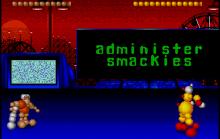Spaceward Ho!
Press Keyboard right side: Alt+Enter keys to switch to full screen game play, and Alt+Enter keys to return.
How to play Spaceward Ho!
Each game uses different controls, most DOS games use the keyboard arrows. Some will use the mouse.
Spaceward Ho! Description
The gameplay of Spaceward Ho! focuses on efficiently extracting the resources of conquered worlds while correctly anticipating and countering opponents' actions.
Spaceward Ho! can be played against an unusually competent computer AI, or against other human players over the internet (via spacewardho.net). Previous versions of the game allowed also LAN-based networked play, but this feature has been disabled in the Mac OS X version . It has a very simple gameplay compared with most other games in the genre (such as Master of Orion). Depending on the initial settings, games take from about ten minutes to an hour. Its small but dedicated fanbase considers the simplicity to be elegance, and its designers boast that it has gotten faster and more intuitive to play with each new version. All unnecessary complexity has been stripped from the game, resulting in a fast-paced game that still manages to be very engaging.
The core of the game is the two-dimensional map of "planets." Each "planet" has three characteristics: temperature, gravity, and metal. Temperature and gravity are both used to determine how fast colonies can grow and how large they can become (based on the preferred temperature and gravity for the colonizer, which is different for each player); the difference is that a player may spend money to change the temperature ("terraforming") while gravity cannot be changed. Colonies with low population take a certain amount of money per turn to support, while colonies with high population earn money for their owner. Metal can, with money expenditure, be mined for use with shipbuilding. A planet's stats are unknown until explored (to get current info on a planet, a player must have ships in orbit with no enemies present). Travel between planets is via hyperspace (ships cannot encounter each other except at planets), and the time it takes depends on the distance between the origin and the destination on the map, as well as on the speed of the ship in question.
Ships are built with money (representing renewable resources) and metal (representing non-renewable resources). Money and metal are available instantly, wherever needed. There are several different kinds of ships, including the basic Fighter, a Scout with longer range but weaker weapons, a Colony Ship used to found new colonies, Satellites which are cheap but cannot move from the world at which they are built, and in recent versions a few others as well, such as the Tanker and Dreadnought. Each ship has a ranking in each of five technologies: range (determining how far a ship can fly before refueling), speed (determining how quickly ships reach their destinations and who shoots first in a battle), weapons, shields, and "miniaturization". Higher-tech ships cost more money and metal, with the exception of ships with high "miniaturization" which take far more money but less metal. Miniaturization is much less effective when applied to Colony Ships, compared to other types of ships. Ships cannot be upgraded, although old ships can be scrapped to retrieve a portion of their metal. When a ship is destroyed in battle, a smaller portion can also be recovered. The first ship of a given design costs two to four times as much as subsequent units, to account for research and design costs.
There is no ground combat; ships that face an undefended enemy colony simply bombard it from orbit until they or the entire planet population is dead. The planet can then be recolonized by the victor's species. If a battle lasts into the second round of firing, the participants will get information on what happened; if it ends in only one round, the loser will know only that he lost.
In addition to spending on supporting colonies, terraforming planets, mining planets, and building ships, players can spend money on technological research. This raises the available maximum for each of the five ship technologies. There is also a sixth type of research, "Radical", which gives unpredictable advantages such as improved terraforming, information about distant planets, or a temporary advantage in one tech. Most spending in the game follows the Law of Diminishing Returns: it is more effective to spend lightly but constantly on a given tech or planet for a long period of time than to spend heavily for a short period of time. For example, a novice player might reason that allocating 20% of one's income to mining a particular planet would yield twice as much metal as allocating 10%; in fact, it yields only 40% more metal.
A pseudo-logarithmic bar graph displays the player's spending allocations. The player manipulates the bars with the mouse to allocate spending. As one bar is lengthened, the lengths of the other bars are automatically shortened (and vice versa).

Spaceward Ho! - additional information
















